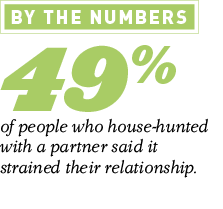How to handle couples’ disagreements over home features
By Myrna Traylor
The challenges REALTORS® face when working with couples are legion, but perhaps one of the most frustrating comes when partners can’t agree on which home features are the most critical to their happiness, and that disagreement hampers the homebuying process.

According to a Porch.com survey that was reported by REALTOR® Magazine, there are some features that tend to divide couples, the top three being wood-burning fireplaces, in-ground pools and hardwood flooring. But the “what” may not be quite as important as the “how”—how an agent will get a couple to resolve their differences and agree on a home.
Start with the list
Agents agree that if they haven’t done so before coming to you, each partner should draft their list of must-haves before they start looking at specific properties. Narrowing that list down to five (or even better—three) “non-negotiables” will set out the parameters for the search. If those items are wildly divergent, it might help to probe a little and set the stage for flexibility.
Mary Lane Sloan, CRS, of The ART of Real Estate in Columbia, South Carolina, makes a point of telling first-time buyers especially, that some of the must-haves might change as they go through the selection process.
“I like to teach them through stories,” says Sloan. “For example, I tell them how one couple told me, ‘Don’t show me anything that doesn’t have a garage,’ and they fell in love with a house that didn’t have a garage. I tell buyers, ‘Don’t box yourself in,’ and establish early in the process that it’s okay to look outside of that list.”
Kari Myhre, CRS, with Park Co. REALTORS® in Fargo, North Dakota, has a similar approach. “First-timers tend to be unrealistic. I tell them it will be difficult to get everything on their list, but that they might be surprised and ultimately buy something they weren’t looking for.”
in Fargo, North Dakota, has a similar approach. “First-timers tend to be unrealistic. I tell them it will be difficult to get everything on their list, but that they might be surprised and ultimately buy something they weren’t looking for.”
Christi Mossburg, CRS, of RE/MAX by the Bay in Fairhope, Alabama, also takes a practical approach to using the list. “As you’re out looking at homes, you can see how strongly they feel about their favorite features. If you know their top three must-haves, you’ve got to give each person one of their top non-negotiables.”
To make matters more complicated, sometimes a couple feels pressure coming from outside of the relationship. “A lot of people—parents, friends and you as their agent—are telling them what they need to do,” says Sloan. “That pressure can make people edgy.” Myhre says that it’s better to find out if parents are having a big influence over the decision-making process.
“I joke with them and ask them if mom has the down payment. That gives them permission to disagree with the ‘advice.’”

The second (or third) time around
Agents report that first-time buyers aren’t the only ones who bicker. Coping with couples moving into a second or third home can be difficult, says Myhre, “because they don’t have to move. They can be pickier.”
Sloan uses an analogy to describe how she approaches repeat buyers: “I always equate it to making waffles: The first one never turns out as well as the fourth or fifth one, but you wouldn’t have that knowledge if you hadn’t made the first one. So your first house is a learning experience—buying it and living in it, so you know what you’d like to have in the next house.”
“It’s our job to home in on what’s most important to them,” says Mossburg. “I use a pre-interview to understand what they like or don’t like about their current house. I listen and get a feel for what’s important for day-to-day living in a home.”
Tactics for diffusing tension
So, what can agents do when things get heated or the parties are not budging on what they want?
“I find that when people are disagreeing or having a hard time compromising, I have them make a ‘con-con’ list, because pros always look better than cons,” explains Sloan. “I have them sit down and make a list, together or separately, to tell me the cons of buying this house and the cons of NOT buying this house. It helps them to look at their pain threshold so they can say, ‘Yeah, this house doesn’t have a garage, but it has everything else we want. And nothing else like this has come on the market in the last six months in our price range—so, the con of NOT buying the house is that we’d have to live with our parents for six more months.’”
That can help crystallize issues for buyers. “When I look at their con-con list, I can see what makes them most uncomfortable, then I can help guide them to overcome those objections,” Sloan says.
Agents also agree that patience and humor go a long way to keeping warring parties on target. “You have to wear many hats—psychologist, negotiator—and stay calm when a couple has high stress. I do better with humor to loosen up people,” says Mossburg.
“I feel I’m like a bartender,” says Myhre, “trying to keep things light. Sometimes it’s best to be a listener rather than a talker.”
“Not too many couples get into fights or screaming matches—although that does happen once in a while,” reports Sloan. “But a big part of my job is keeping people focused and calm. I tell stories and jokes to try to keep it light when I see people getting flustered or tense with each other. I have a Pinterest page of crazy things I’ve seen in houses since I’ve been selling [since 2007], so I divert them with, ‘Oh my gosh, let me show you what I saw the other day … ’ I just redirect—which works with kids.” Sloan would know; she’s a former public school teacher. “Yeah, I tell people all the time that I teach big kids about buying houses.”
The webinar “Home Tips for First-Time Homebuyers” will help you learn how to be a better trusted advisor to clients and guide them through the process. Visit CRS.com/learn for information about RRC webinars.








